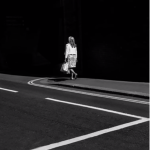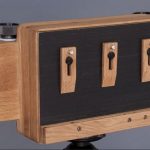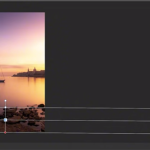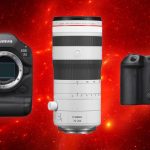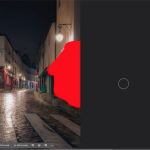
The post Loop Lighting: A Comprehensive Guide appeared first on Digital Photography School. It was authored by Kevin Landwer-Johan.

The way you light a portrait influences so much: How the person appears, the depth and three-dimensionality of the scene, and even the overall mood conveyed by the photograph.
Loop lighting is just one method of illuminating a subject – yet if you use this technique, you can be pretty certain that whoever is sitting in front of your camera will like the results. Plus, loop lighting is extremely easy to set up; you only need a single light source (which can be ambient light, a speedlight, a studio strobe, or a continuous light).
In this article, I offer a comprehensive overview of loop lighting. I explain what loop lighting is, when you should use it, and a simple, step-by-step approach for creating the lighting pattern in your own photos.
So if you’re ready to revolutionize your portrait photography, then let’s get started!
What is loop lighting?
Loop lighting is a popular lighting pattern that creates a shadow under and to one side of the subject’s nose; this small “loop” gives the pattern its name.

To create the loop of shadow, you can position your main (key) light so it’s above and slightly to the side of your subject. Note that, along with the loop shadow cast by your subject’s nose, some of the subject’s face will be in shadow, and they’ll also have a shadow under their chin.
The size and intensity of the loop shadow depend on:
- The type of light
- The light’s position
- Whether the light is direct or diffused
- The amount of ambient light
- Other light sources or reflectors
Even once you have a loop lighting approach dialed in, the way you manage your main light will dramatically alter the results. If your key light is positioned farther away from your subject, the lighting intensity will change. And as you move the light to one side or the other, higher or lower, the shadows on your subject will change, too.
Of course, if you adjust the position of your key light too much, you’ll eventually lose the loop lighting effect; instead, you might create another common pattern, such as Rembrandt lighting, split lighting, or butterfly lighting.

When should you use loop lighting?
If your goal is to create a highly flattering portrait, then loop lighting is one of your best options.
As I mentioned above, it’s easy to set up; you only need a few pieces of lighting gear (or nice ambient lighting).
And because loop lighting requires minimal gear, you can spend more time connecting with your subject. You’ll also have more opportunities to make sure your camera and lens are behaving as desired.
What makes loop lighting so flattering? It’s very gentle on your subject’s face. Yes, it creates some shadows, but they aren’t very harsh (compared to other lighting styles). Instead, loop lighting produces light and shadow that show the facial contours pleasantly. As long as you can get the angle of light right, the shadows will complement the person nicely.
Other techniques, such as Rembrandt lighting, produce shadows that cover more of the face. If you want your portraits to feature a more intense feel, such an approach works well; in fact, dark shadows on the face tend to add drama and even mystery because part of the face is hidden.
However, if your goal is to create a beautiful portrait that emphasizes the subject’s features, loop lighting is a better option.
By the way, people with more oval-shaped faces will especially appreciate the loop lighting technique. Why? It accentuates cheekbones, which tends to create a slimming look.

Getting started with loop lighting: step by step
When you start doing studio portraiture, it’s a good idea to experiment with a wide variety of lighting styles and techniques. Loop lighting is a great first option.
Because loop lighting is both easy and flattering, you’re far more likely to receive positive feedback from the person you’re photographing, which will encourage repeat shoots and referrals (it’ll make you feel more motivated, too!).
Remember: The less you need to pay attention to the lighting, the more you can focus on communicating with your subject. So start out with an easy, one-light setup. Only add a reflector or a second light source once you’ve had plenty of time to practice.
So how should you approach loop lighting for the first time? Here’s my recommended step-by-step approach:
Step 1: Prepare yourself for the photoshoot
Before your subject arrives, make sure that you’re ready to capture a loop-lit photo.
Take a look at the location. Think mainly about the ambient light and the background. Will you rely on available light? Or will you add a light source to create the loop lighting effect? Where will you position your light source and subject?
Ensure you have all the necessary gear; if you plan to use artificial lighting, set up your equipment in advance and make sure it all works as expected.
The more you can determine before your subject even arrives, the better your results will be.
Step 2: Position your light source
Once your subject arrives, ask them to stand or sit in position, then adjust your light so it’s slightly above and to the side of their face. The goal is to create that little loop of shadow under the nose, and I encourage you to clearly communicate this with your subject; otherwise, they’ll have no idea what you’re trying to achieve.
If you’re using a speedlight or strobe, you’ll generally need to capture a series of test photos. Take a shot, check the results on the back of your camera, adjust the light’s position, and shoot again. It may take a few tries before you see a nice loop shadow, and that’s okay – though the more efficient your testing process, the more comfortable the subject will feel.
If you’re worried about the setup process and/or you need to work quickly, consider starting with a continuous light source (such as an artificial continuous light or ambient light). That way, you can see where the shadows fall on the face, and you can skip the entire testing process.
Regardless, I find that talking to people about what I am doing and how I want them positioned helps them feel relaxed. If you take people through the photoshoot process, they’ll feel more confident, which shows in their facial expressions.
Step 3: Modify the lighting
At this point, you should have that nice loop-lighting shadow, but it often pays to refine the overall effect.
For instance, you can bring in a reflector – and while this isn’t absolutely necessary, it’ll soften the shadows on the subject’s face for an even more flattering result.
You can test out a few different reflector positions: beneath the subject’s chin, on the side opposite the light source, or somewhere in between. As you move the reflector, pay careful attention to the shadows on your subject’s face; the difference may be subtle, but it can be very significant.
Adding some diffusion to the light source will also help soften the shadows, which will make the image less dramatic. Of course, less drama isn’t always ideal, so you’ll need to decide if this is the type of look you want.

Step 4: Add a second light
You can create a beautiful loop lighting effect with just one light source, but if you want to take your portraits to the next level, consider adding a light behind your subject.
Make sure the light is positioned either directly behind your subject or just outside the frame. It should be directed at your subject’s back, though you’ll need to make sure the spread is confined to the subject’s head and shoulders; the goal is to help them pop off the screen, which is especially important when you’re capturing dark hair on an already-dark backdrop.
Loop lighting: final words

Loop lighting is a simple and effective technique for flattering portraits. You don’t need anything other than your camera, a lens, and a light source, so it’s great for beginners (though using additional lighting gear will give you more options).
So practice the technique until you know it well. As with any simple lighting style, you can tweak aspects of your setup to achieve different looks, so don’t be afraid to experiment. And make sure you communicate with your subject along the way!
The more you practice, the better you’ll get, and the more you’ll please your subjects. Happy shooting!
How do you plan to use loop lighting in your next photoshoot? Share your thoughts in the comments below!
The post Loop Lighting: A Comprehensive Guide appeared first on Digital Photography School. It was authored by Kevin Landwer-Johan.


